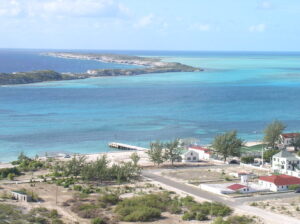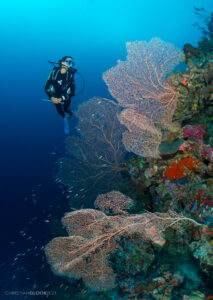Swim with the Sharks?
The Surface
 3,100 miles away from the Caribbean, I sat in a rickety room just off campus prodding the interviewer with questions. She had asked me if I had any concerns about living on the small island of South Caicos. “What kind of sharks are there?” I felt childish to ask, and anxious that I’d paint myself unfit for a three-month marine research residency. But my fear of the unknown seascape won out, so I pressed on. “Are student divers safe from these sharks?”
3,100 miles away from the Caribbean, I sat in a rickety room just off campus prodding the interviewer with questions. She had asked me if I had any concerns about living on the small island of South Caicos. “What kind of sharks are there?” I felt childish to ask, and anxious that I’d paint myself unfit for a three-month marine research residency. But my fear of the unknown seascape won out, so I pressed on. “Are student divers safe from these sharks?”
 I grew up in the national parks of Wyoming, where I often returned home from school to see moose or elk grazing my front yard. Cruising through windy park roads, I sometimes spotted black bears and grizzlies through the trees. Even wolves occasionally strayed from the seclusion of their den, venturing into open valleys where I strained to see them from a hiking trail. Large wildlife feels to me more familiar than intimidating. Be “bear aware,” keep your distance. I know the steps to keep myself safe in the mountainous Rockies.
I grew up in the national parks of Wyoming, where I often returned home from school to see moose or elk grazing my front yard. Cruising through windy park roads, I sometimes spotted black bears and grizzlies through the trees. Even wolves occasionally strayed from the seclusion of their den, venturing into open valleys where I strained to see them from a hiking trail. Large wildlife feels to me more familiar than intimidating. Be “bear aware,” keep your distance. I know the steps to keep myself safe in the mountainous Rockies.
 Sharks were a different story. I had always been drawn to the beach, to the warmth of sun and sand pressing into my skin. But I rarely journeyed out into the water past the point where my toes could still graze the ocean floor.
Sharks were a different story. I had always been drawn to the beach, to the warmth of sun and sand pressing into my skin. But I rarely journeyed out into the water past the point where my toes could still graze the ocean floor.
Slowed by the weight of the water, I couldn’t imagine immersing myself in the depths of a shark’s domain. But this time, the call of a semester on island time overwhelmed my hesitations, and soon I boarded a plane to trek the 3,100 miles.
Below

 After several training dives, I relax enough to finally take in the water around me. It quickly becomes clear that I am simply a passerby, neither invited nor unwelcome. The blue expanse is only bound by deeper shades of sapphire, cobalt, and midnight. Reefs occasionally rise up out of the seafloor, peppered with corals and algae. Fish of every color and shape dart around the border. Some eagerly parade amongst the sea fans; others watch cautiously from crevices. The sharks I so feared occasionally appear in the near distance. They cruise along the underwater shelf where the most interesting corals cling to the edge, bathed in the nutrients upwelling from the deep ocean. Their lack of interest in my presence quickly humbles me.
After several training dives, I relax enough to finally take in the water around me. It quickly becomes clear that I am simply a passerby, neither invited nor unwelcome. The blue expanse is only bound by deeper shades of sapphire, cobalt, and midnight. Reefs occasionally rise up out of the seafloor, peppered with corals and algae. Fish of every color and shape dart around the border. Some eagerly parade amongst the sea fans; others watch cautiously from crevices. The sharks I so feared occasionally appear in the near distance. They cruise along the underwater shelf where the most interesting corals cling to the edge, bathed in the nutrients upwelling from the deep ocean. Their lack of interest in my presence quickly humbles me.
I still can’t trust my natural rhythms, so I steadily pull each breath as if I could forget how to inhale at any second. Yet each dive brings more and more ease in my second world. During a night dive, I turn off my dive light and for a brief second turn my back to the lights of the group. Staring off into the true black, I feel as if I’ll never be closer to outer space.
The unique calm of silence under the surface starts to reveal itself. It is not a complete silence. Methodical rasps accompany each breath in, followed by an exhale of bubbles that wobble around my head and up toward dancing rays of light. Occasionally a boat overhead drones faintly across the waves. These sounds fade into a familiar soundtrack, detached from meaning. Only two tasks occupy my focus: to breathe, to observe. It is stunning how twenty to thirty minutes of slow, wonderous breaths can stall time. I learn to melt into my surroundings in a way I never experience above.
Above
Back in the city, I seem to hear everything but silence. I rejoin the masses of people scurrying through a seemingly endless maze of meetings, appointments, decisions, deadlines. Tension hangs in the air, suspended just above the sidewalks like a fog. DC remains one of my favorite places, but I can’t deny the sense of collective angst driven by fast walkers and hurried transactions. Each commitment ratchets up the volume a small but distinct notch. Notifications constantly light up my phone. I can’t look away. I feel proud of myself for taking a 30-minute tech-free walk every few weeks, then sad that it’s become a victory at all. Even my free time fills with noise like air fills a vacuum. Music or political news ping pongs between my headphones all day. I consume it eagerly, grateful to feel that my frustrations and fears are shared. But it still cuts the silence, robbing my mind at a chance of true rest.
I aim to strike a balance at the surface. I’m one of the fast walkers. I hold my head steadily above. But occasionally, as I do my yoga or take my walk, I can slow my thoughts enough to realize how fast they’ve been running. Duck my head under long enough to feel the familiar calm of methodical inhales and exhales.
 RCC Stanback Presidential Fellow – Stephanie Murphy
RCC Stanback Presidential Fellow – Stephanie Murphy
Stephanie is co-lead of the RCC Coasts and Ocean program. She is a Master of Environmental Management candidate at Duke University where she specializes in environmental economics and policy. Prior to beginning her master’s, Stephanie spent 3 years working on federal ocean policy and program management at the Consortium for Ocean Leadership in Washington, D.C.
![]() The Rachel Carson Council depends on tax-deductible gifts from concerned individuals like you. Please help if you can.
The Rachel Carson Council depends on tax-deductible gifts from concerned individuals like you. Please help if you can.
![]() Sign up here to receive the RCC E-News and other RCC newsletters, information and alerts.
Sign up here to receive the RCC E-News and other RCC newsletters, information and alerts.






